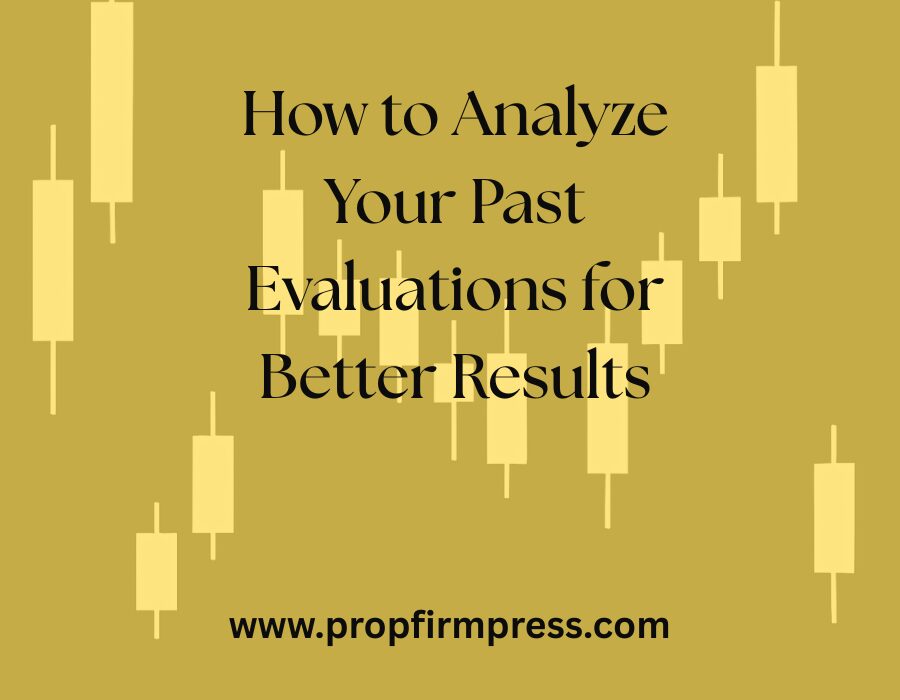Why Reviewing Past Evaluations Is a Trader’s Superpower
Too many traders pass or fail prop firm evaluations and immediately jump into the next one—without taking time to understand what actually happened. But analyzing your previous evaluations can be the single most important factor in finally getting funded or staying funded. It helps reveal the exact behaviors, patterns, and psychological triggers that made or broke your performance. In a competitive space like prop trading, your greatest edge might not be a better strategy—it might be a better understanding of yourself.
Step 1: Gather All Evaluation Data
If your prop firm offers performance analytics (most do), export or screenshot your full evaluation report. This typically includes:
- Total profit and loss
- Average R per trade
- Daily profit curve
- Drawdown events
- Violations or resets
<liWin rate (%)
Firms like Bulenox, Funded Futures Network, and Prop Shop Traders provide detailed dashboards you can use to see your journey through each challenge phase.
Step 2: Identify Your Best and Worst Days
Sort your trades by date or session. Mark:
- Your most profitable day
- Your biggest losing day
- Any day you violated a rule
Then ask: What was different? Was it the time of day? The market session? Your mood? The strategy you used? By comparing highs and lows, you’ll start to isolate patterns.
Step 3: Label Each Trade by Strategy
Assign a label to each trade (e.g., “Pullback to EMA,” “VWAP Rejection,” “Breakout Fakeout”). Then check:
- Which setups had the highest win rate?
- Which had the best R-multiple?
- Which ones lost money consistently?
This step alone can help you refine your playbook and drop the setups that drag your performance down.
Step 4: Track Emotional Decisions
Were you following your plan, or were you reacting emotionally? Use a 1–5 discipline score in your journal:
- 5 = fully disciplined, followed plan
- 1 = full revenge-trading meltdown
High-discipline days with poor results are still wins. Low-discipline days—even profitable ones—are red flags for future blowups. Be honest with yourself here.
Step 5: Calculate Rule Breaches
How many times did you come close to violating the daily loss limit? Did you average near your max drawdown?
- If yes, your risk-per-trade is likely too high
- If no, you may be under-trading or being too cautious
Use this data to fine-tune your risk parameters for the next challenge.
Step 6: Evaluate Your Time-of-Day Performance
Did most of your wins happen in the morning session? Were afternoons full of choppy losses? Time-of-day bias is real, and your data can prove it. Avoid trading during your statistically weakest periods, even if your setup shows up. Consistency is more important than opportunity.
Step 7: Use a Performance Tracker
Don’t rely on memory. Use performance sheets like the Prop Firm Press Evaluation Tracker or a spreadsheet to log and review:
- Total number of trades
- Winning trades vs losing trades
- Biggest winners and losers
- Most frequent mistake (e.g., overtrading, early exits)
This creates visual feedback loops that you can reference before each new challenge.
Step 8: Adjust Your Plan Based on What Worked
If your average winning trade was 1.5R but your losers were -2.0R, your next step is clear: tighten your stops, improve your exit logic, or reduce your size until consistency improves. Use past performance to guide smart, data-backed tweaks—not gut feelings.
Step 9: Create a Pre-Challenge Checklist
After analyzing multiple evaluations, create a personal checklist. This could include:
- Only trade between 9:30 AM – 12 PM
- Risk no more than 0.5% per trade
- Trade only pullback setups with confirmation
- Log each trade before entering the next
This turns your personal insights into rules you can follow.
Step 10: Run a Simulation Challenge
Before you pay for your next evaluation, run a mock challenge using a sim account with the same rules. Treat it like real. If your data analysis was honest and your adjustments were smart, this sim test should go much smoother than your previous real attempts.
Learning from Failure Is the Fastest Way to Pass
If you’ve failed a challenge, you’re in good company. Most traders do. What separates future funded traders from those who give up is reflection. Analysis makes failure temporary. Without it, failure becomes a pattern.
Final Word
Data doesn’t lie. Your evaluations contain everything you need to improve—if you take the time to break them down. Don’t let past evaluations collect digital dust. Use them to fine-tune your edge and finally pass your next prop firm challenge with confidence.
